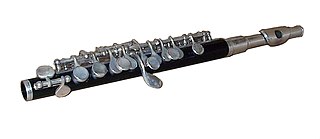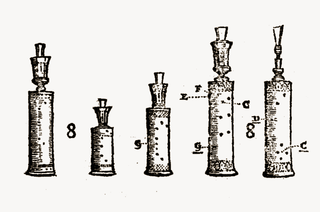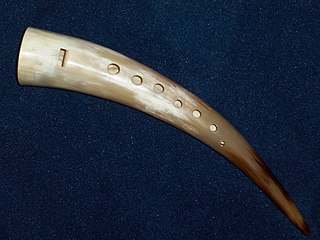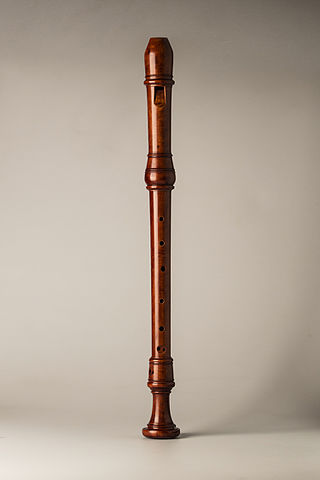
The recorder is a family of woodwind musical instruments in the group known as internal duct flutes: flutes with a whistle mouthpiece, also known as fipple flutes. A recorder can be distinguished from other duct flutes by the presence of a thumb-hole for the upper hand and seven finger-holes: three for the upper hand and four for the lower. It is the most prominent duct flute in the western classical tradition.

The piccolo is a half-size flute and a member of the woodwind family of musical instruments. Sometimes referred to as a "baby flute" the modern piccolo has similar fingerings as the standard transverse flute, but the sound it produces is an octave higher. This has given rise to the name ottavino, by which the instrument is called in Italian and thus also in scores of Italian composers.

The rackett, raggett, cervelas, or sausage bassoon is a Renaissance-era double reed wind instrument, introduced late in the sixteenth century and already superseded by bassoons at the end of the seventeenth century.

The gemshorn is an instrument of the ocarina family that was historically made from the horn of a chamois, goat, or other suitable animal. The gemshorn receives its name from the German language, in which Gemshorn means a "chamois horn".
The soprano recorder in c2, also known as the descant, is the third-smallest instrument of the modern recorder family and is usually played as the highest voice in four-part ensembles. Since its finger spacing is relatively small, it is often used in music education for children first learning to play an instrument.
The flûte d'amour is an uncommon member of the Western concert flute family, pitched in A♭, A, or B♭ and is intermediate in size between the modern C concert flute and the alto flute in G. It is sometimes thought of as the mezzo-soprano member of the flute family. It is also sometimes called a tenor flute.

Zuffolo (also chiufolo, ciufolo) is an Italian fipple flute. First described in the 14th century, it has a rear thumb-hole, two front finger-holes, and a conical bore. It is approximately 8 cm in length and has a range of over two octaves, from B3 to C6 (Marcuse 1975c). A larger instrument of the same name, with a lowest note of C5 appeared in the early 17th century (Fuller-Maitland, Baines, and Térey-Smith 2001).
Sebastian Virdung was a German composer and theorist on musical instruments. He is grouped among the composers known as the Colorists. He studied in Heidelberg as a scholar of Johannes von Soest at the chapel of the ducal court. After being ordained, he became chaplain at the court in Heidelberg. Virdung sung in the choir as a male alto until 1505/1506. Around 1506 he became a singer in the chapel of the court of Württemberg in Stuttgart. The following year, in January 1507, he received one of nine succentorships at Konstanz Cathedral where he educated the choirboys until he was dismissed in 1508 presumably for his difficult temperament.

The great bass recorder is a member of the recorder family. With the revival of the recorder by Arnold Dolmetsch, who chose Baroque music and the corresponding recorder types as a fixed point, consideration was given to the design of recorder types larger than the bass recorder. The great bass recorder has up to seven keys, which serve to facilitate access to the finger holes. For modern large bass recorders woods like maple or African Bubinga are used. The term usually applies to an instrument with range is c–d2 (g2), but has also been used to describe an instrument descending to B♭ or else to the low bass recorder in F, alternatively known as a contrabass. When "great bass" is used for the instrument in low F, the instruments in C and B♭ are referred to as "quart-bass" and "quint-bass", respectively, because they are a fourth and fifth below the ordinary small bass, or "basset". The prefixes "great" and "contra" refer to the registers from C to B and from ͵C to ͵B, respectively, in Helmholtz pitch notation.
Fitzwilliam Sonatas is the name first given by Thurston Dart to an arrangement he made, based on two recorder sonatas by George Frideric Handel, which he recast as a group of three sonatas. The term was applied by later editors to the original two sonatas as Handel wrote them, and was also expanded to encompass several other sonatas for various instruments included in the Handel autograph manuscripts held by the Fitzwilliam Museum in Cambridge.

Rob du Bois was a Dutch composer, pianist, and jurist.
The sopranino recorder is the second smallest recorder of the modern recorder family, and was the smallest before the 17th century.
Michael Vetter was a German composer, novelist, poet, performer, calligrapher, artist, and teacher.

In music, a Flute method is a kind of specific textbook style manual for playing the flute. It usually contains fingering charts and/or scales and numerous different exercises, sometimes also simple etudes, in different keys, in ascending order as to difficulty or with a focus on isolated aspects like fluency, rhythm, dynamics, articulation and the like. Sometimes there are duets or even recital pieces, also with accompaniment. Such methods differ from etude books in that they are meant as a linear course for a student to follow, with consistent guidance, whereas volumes of etudes are not as comprehensive.
The garklein recorder in C, also known as the sopranissimo recorder or piccolo recorder, is the smallest size of the recorder family. Its range is C6–A7 (C8). The name garklein is German for "quite small", and is also sometimes used to describe the sopranino in G. Although some modern German makers use the single-word form Garkleinflötlein, this is without historical precedent. Double holes for the two lowest notes (used on the larger recorders to achieve a fully chromatic scale) are uncommon. The instrument is usually notated in the treble clef two octaves lower than its actual sound. The garklein recorder is only about 16 to 18 cm long and is different from larger recorders in that it is usually made in one piece due to its size.

A bass recorder is a wind instrument in F3 that belongs to the family of recorders.

The tenor recorder is a member of the recorder family. It has the same form as a soprano recorder and an alto recorder, but it produces a lower sound than either; a still lower sound is produced by the bass recorder and great bass recorder.

The contrabass recorder is a wind instrument in F2 that belongs to the family of recorders.

The voice flute (also the Italian flauto di voce and the French flûte de voix are found in English-language sources) is a recorder with the lowest note of D4, and is therefore intermediate in size between the alto and tenor recorders.
Peter Bressan was a noted woodwind instrument maker of whose work several examples exist in museums and private collections.










